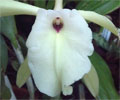|
|
|
|
 |
Email Address Recovery or Password Reset |
Use our Change Password page, and you can set a new password, or if you don't remember which email address you
registered with, the same page may be able to suggest it based on another you enter.
|
|
|
|
|
| |
Flasks of
Rhyncholaelia glauca 'Rebecca' × self |
|
| |
|
|
| |
|
|
Click to Enlarge

Pod Parent Flower |
Click to Enlarge

Pod Parent Closeup of Labellum |
|
|
|
| |
For additional origin/habitat information supplied courtesy of
Charles and Margaret Baker, see further below, near the bottom of this page.
|
Temperatures we attempt to use in the lab & greenhouse:
| For Species: |
|
Spring, Summer, Autumn: days average 76°F, nights 64°F; best fit is Cool-Intermediate 75-58°F
(Source:
Baker's Web OSC) |
| For Species: |
|
Winter: days average 67°F, nights 56°F; best fit is Cool 70-52°F
(Source:
Baker's Web OSC) |
|
About the name...
| Etymology of |
glauca |
|
From latinized Greek "glaucus" shining blue-green.
(Source:
Mayr & Schmucker 1998) |
| Etymology of |
Rhyncholaelia |
|
From latinized Greek "rhynchos" beak. From the elongated fruit and some similarities to the genus Laelia.
(Source:
Mayr & Schmucker 1998) |
| Pronunciation of |
glauca |
|
GLAW-ka
(Source:
Hawkes 1978) |
| Pronunciation of |
Rhyncholaelia |
|
rink-oh-LYE-lee-ah
(Source:
Hawkes 1978) |
|
If you would like to direct someone to this web page, please copy and paste this URL into your email:
http://troymeyers.com/d?017446
| Flask Information |
| Availability: |
We have sold all of the flasks for this item. |
| You should: |
Consider getting individual plants or compots instead of a flask.
See if we have plants available in the greenhouse. |
| Yield Estimate: |
440 plants (based on flask surveys done 10/31/2013 through 05/05/2014)
|
| Plantlet Sizes: |
From many flasks 30 - 60 mm plants (based on flask surveys done 09/26/2014 through 01/05/2015)
From one most recently surveyed flask 30 - 50 mm (01/05/2015)
|
|
You might also want to:
|
View the seed assay for this item.
See if we have plants available in the greenhouse.
View items of the same species.
View items of the same genus.
|
| Ordering Information |
| You are not currently logged in. |
|
You must be a registered user and be logged in to reserve a flask or place a notification request. Please log in:
|
|
 |
Email Address Recovery or Password Reset |
Use our Change Password page, and you can set a new password, or if you don't remember which email address you
registered with, the same page may be able to suggest it based on another you enter.
|
|
|
|
|
|
|
|
| |
The origin/habitat information below is supplied courtesy of Charles and Margaret Baker
The following information is based on the name of the plant provided by the donor, and assumes that the name is correct. If the plant has been misidentified, then the following information may not be correct.
This text is copyrighted by the Bakers and may not be reproduced without permission.
ORIGIN/HABITAT: Mexico, southward to Nicaragua through Guatemala, and
Honduras. Plants were first found near Xalapa (Jalapa), Mexico and later
not far from Veracruz. Rhyncholaelia glauca occurs over a wide area, but
it is not common in any of its habitats. Plants are often grow either on
the surface of the ground or in trees in dry, open mountain forests at
3950-4920 ft. (1200-1500 m). However, they occasionally grow at lower
elevations in dense tropical forests.
More about this information and the Bakers...
|
|
|
| |
|
|
|